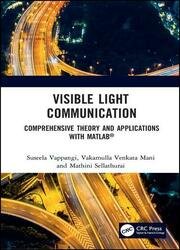Visible Light Communication: A Comprehensive Theory and Applications with MATLAB
- Добавил: literator
- Дата: 6-08-2021, 04:03
- Комментариев: 0
 Название: Visible Light Communication: A Comprehensive Theory and Applications with MATLAB
Название: Visible Light Communication: A Comprehensive Theory and Applications with MATLABАвтор: Suseela Vappangi, Vakamulla Venkata Mani
Издательство: CRC Press
Год: 2022
Страниц: 503
Язык: английский
Формат: pdf (true)
Размер: 14.4 MB
The field of visible light communication (VLC) has diverse applications to the end user including streaming audio, video, high-speed data browsing, voice over internet and online gaming. This comprehensive textbook discusses fundamental aspects, research activities and modulation techniques in the field of VLC.
Visible Light Communication: A Comprehensive Theory and Applications with MATLAB® discusses topics including line of sight (LOS) propagation model, non-line of sight (NLOS) propagation model, carrier less amplitude and phase modulation, multiple-input-multiple-output (MIMO), non-linearities of optical sources, orthogonal frequency-division multiple access, non-orthogonal multiple access and single-carrier frequency-division multiple access in depth. Primarily written for senior undergraduate and graduate students in the field of electronics and communication engineering for courses on optical wireless communication and VLC, this book:
- Provides up-to-date literature in the field of VLC
- Presents MATLAB codes and simulations to help readers understand simulations
- Discusses applications of VLC in enabling vehicle to vehicle (V2V) communication
- Covers topics including radio frequency (RF) based wireless communications and VLC
- Presents modulation formats along with the derivations of probability of error expressions pertaining to different variants of optical OFDM
The rapid proliferation in the acquisition of mobile devices like smart phones, palmtops, laptops and a massive number of connected internet of things (IoT) devices leads to an insatiable demand for data access over the wireless networks. During the last 3 decades, tremendous growth in mobile data traffic has been witnessed. Even though the network providers are providing additional services, still there is a requirement to meet this unquenchable demand for data. This explosive growth in mobile data traffic is further fueled by the huge demand of end users access to many multimedia applications like high definition television, live video streaming, streaming audio, video conferences, high-speed internet access and many other such services. Therefore, in order to accomplish the aforementioned services, the quest for high bandwidth is intended to grow at a rapid pace in the near future. Specifically as the global demand for this bandwidth continues to accelerate, it becomes exceedingly difficult for the existing radio frequency (RF) spectrum to accommodate huge amount of services. A day is approaching in the very near future, where the existing RF spectrum emerges as one of the precious resources. This enormous increase in the demand for data manifests to curtail the reliability of services because of huge increase in latency and decrease in network throughput.
Consequently, to alleviate the RF spectrum congestion problem, it is necessitated to explore novel communication-based technologies. One such communication which emerged is optical wireless communication (OWC). When OWC exploits simple, sustainable, cost-effective, solid-state, energy-efficient opto-electronic devices like light emitting diode (LED), it has resulted in the emergence of a novel communication-based technology called visible light communication (VLC). The transmission of data through light is not new to human kind. In the recent times, VLC-based systems are sparking a significant propulsion due to wide-scale deployment of LEDs in a multitude of applications. The most distinguished characteristics of LEDs include: high tolerance to humidity, lower power consumption, longer lighting hours, cooler and smoother operation, and evolution of the future lighting system as LED-based.
Скачать Visible Light Communication: A Comprehensive Theory and Applications with MATLAB
[related-news] [/related-news]
Внимание
Уважаемый посетитель, Вы зашли на сайт как незарегистрированный пользователь.
Мы рекомендуем Вам зарегистрироваться либо войти на сайт под своим именем.
Уважаемый посетитель, Вы зашли на сайт как незарегистрированный пользователь.
Мы рекомендуем Вам зарегистрироваться либо войти на сайт под своим именем.
